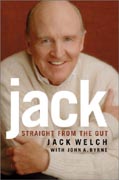“Whirlwind” is defined as, among other things, “a tumultuous rush.” That definition aptly describes life with Jack Welch as depicted in his heavily hyped autobiography, Jack: Straight from the Gut. Throughout his 40 years with General Electric, and especially in his 20 years as the company’s chief executive, Welch was in constant motion, prodding the lumbering bureaucracy he inherited on his accession to the top job in 1981 to become limber, lean and even lithe. By every standard metric, Welch was remarkably successful. Under his leadership, GE grew to become one of the world’s largest, most profitable companies. What was even more remarkable was Welch’s ability to produce such extraordinary results year after year. More than 75% of the corporations that were part of the Fortune 500 50 years ago are gone, yet GE continues to glow. There is more here than we either need or want to know. He was paid to write about his 20 years at the helm of General Electric, and that is what we get. The writing is often poor, the book jumps all over the place and facts get muddled here and there. The skilled hand of his collaborator, John A. Byrne, a senior writer at Business Week and author of a number of excellent business books, is not all that apparent. But none of that really matters. We wanted Jack and this book gives him to us. What we learn is that Jack started out in life as a relatively ordinary guy, with average intelligence and average prospects. He had a normal childhood, a devoted mother, and a good, if detached, father. But somewhere along the line he developed a hunger, not for success or money (although those both came in abundance), as much as for ways to improve: improve products, processes and people, as well as himself. His hunger turned into an insatiable appetite once he joined stolid, stodgy General Electric in 1961. Within a very short time, he literally blew things up, albeit unintentionally, as he sought to find a way to improve the production of plastic. He shares with us his various recipes for success, beginning with his strategy that every GE product should either be “Number 1, Number 2, or abandoned.” Many companies still follow that recipe, long after GE refined it once Welch learned that many of the company’s managers were defining their markets so narrowly that virtually every product became number 1. Welch then told his managers to redefine markets so that each product had no more than a 10% market share. That simple directive opened the way for enormous gains over the past decade. “Markets aren’t mature. Sometimes minds are … When we asked each business to redefine its market so that they could have no more than a 10% share, what had looked like mature markets became growth opportunities. Even a few field horses started looking like thoroughbreds.” Perhaps Welch’s most successful initiative came in the mid-1990s, when he pushed the concept of “boundaryless organization.” Knowledge and information have increasingly become a company’s most important strategic resource. Unhappily, the aphorism “knowledge is power” is all too true in large organizations, where information becomes sticky as even managers within the same division find themselves reluctant to share or transfer knowledge. Welch developed ways to eliminate the barriers that kept knowledge from being shared widely, including his well-known “work-out” sessions. “Taking everyone’s best ideas and transferring them to others is the secret. There is nothing more important.” But there is also nothing more difficult, as Welch found out. Welch loved throwing old nostrums of business overboard. He relished intellectual combat, challenging the ideas others generated, not in an effort to impose his own ideas, but to hone the development of the idea that was best for the company. He readily admits that not all his ideas were winners. He celebrated the occasional misstep, as well as the successes. He knew how important it was to encourage people to try and to take risks. What comes through in this book, and may be the key to his success, is that Welch genuinely likes people, and believed in every one of the 300,000 employees of the company. Yes, he could be demanding, direct and blunt, but employees rarely misunderstood him. People were not just fungible goods, resources to be used or gotten rid of; they were to be developed. “We ran the people factory to build great leaders.” Welch may be one of the few CEOs to have raised the human resource department to a level equal with, if not a slight notch above, the operating divisions. He hammers home the theme: People make the difference. We hear that from many CEOs, but coming from Welch it has credibility. Like many other successful CEOs, he was highly competitive, smart, and devoted to the company. But most important, he was devoted to the people who worked for the company. Welch spent his 20 years as CEO to “making sure everybody counts – and everybody knows they count.” For Welch, formality, titles and hierarchy were not what mattered. “Passion, chemistry and idea flow from any level at any place are what matter. Everybody’s welcome and expected to go at it.” The mantra that drove Jack throughout his career and made him one of the world’s most successful and admired executives seems to have been a slight and elegantly simple variation on GE’s slogan: “We bring good people to life.”
Looking for more insights?
Sign up to stay informed about our latest article releases.



